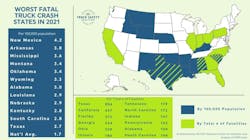Can speed limiters and AEB really make highways safer?
After a gruesome highway crash that claimed six lives, investigators cited a heavy-duty truck driver for following too close and creating fiery chain-reaction collisions on Interstate 70 in Ohio. While the National Transportation Safety Board is still looking into the crash, the U.S. Department of Transportation wants to mandate automatic emergency braking and speed limiters on trucks like the one involved in the I-70 crash.
In conjunction with the Federal Motor Carrier Safety Administration (FMCSA) and the National Highway Traffic Safety Administration (NHTSA), the DOT introduced those plans this year. The AEB mandate is for vehicles exceeding 10,000 lb. GVWR, while the speed limiter mandate would force vehicles with 26,000-lb. GVWR to have a speed limiter, with the exact speed limit currently undetermined.
See also: AEB adoption speeds ahead
Many large carriers already have a full complement of automatic driver assistance system features, including collision mitigation and AEB, limiting drivers’ speeds, or at least monitoring speeding via telematics. But the issue is more divisive for owner-operators and small fleets.
Their anti-regulation stance becomes more difficult to justify when mandate supporters can show imagery of the crumpled remains of an SUV, a mangled, smoldering charter bus that had held nearly 60 teenagers in it, and behind them, a barely recognizable aluminum skeleton of a tractor-trailer.
All eyes on truck crashes
One isolated incident isn’t enough to end the mandate debates, but what this tragedy did was add six more deaths to 2023’s total road death count. This comes while the government is trying to steer toward an aspirational goal of zero road deaths, as Transportation Secretary Pete Buttigieg mentioned.
With the former Rhodes scholar in charge of America’s roads, though, the numbers have been going in the wrong direction. According to National Safety Council (NSC) analysis of 2021 crash data, 5,700 large trucks were involved in fatal crashes, which led to 5,788 fatalities. This was an 18% YOY increase. This is even with the broader use of air disc brakes and advanced driver assistance systems such as collision mitigation. Fatal heavy truck crashes have been on the rise over the past decade. The NCS data also found large truck crashes were up 49% from 2011.
"Truck crash deaths have continued to rise over the last 10 years, demonstrating the need for safety reforms," said U.S. Rep. Eleanor Holmes Norton (D-DC), Highways and Transit Subcommittee Ranking Member, in response to further heavy truck accident data from the Truck Safety Coalition. "Safety was my first priority when working on the Infrastructure Investment and Jobs Act, including mandating automatic emergency braking, stronger standards for rear underride guards, and increased funding for safety programs, among other provisions."
AEBs
NHTSA estimated the AEB mandate would prevent more than 19,000 crashes, save 155 lives, and prevent nearly 9,000 injuries annually. More specifically, NHTSA's Preliminary Regulatory Impact Analysis anticipated that AEB devices were effective almost half the time in preventing lead vehicle moving and lead vehicle decelerating crashes in Classes 7-8 (49.2% effective) and Classes 3-6 (47.8% effective) vehicles.
Fred Andersky, Bendix director of government and industry affairs, agreed that AEB systems can reduce the severity of a crash, but even if mandated on every vehicle, they will not prevent all crashes.
"When you take a look at the performance testing requirements, they're really looking at crash avoidance, meaning that the system is going to avoid all crashes between certain speeds that they've laid out," Andersky explained. "The reality is that this technology is collision mitigation. We can't guarantee that the vehicle's not going to hit the vehicle. The goal is to get the driver back into the game from whatever distraction may be involved and help take energy out of the potential collision."
See also: Results from CVSA's 2023 brake safety event
Proponents of the mandate argue that even if the ruling saves only a few lives, then the wide-reaching regulation would be worth pursuing in the interest of public safety. That argument would not be made by truckers who have experienced glitches with the tech. Some have reported issues with their AEBs where they mysteriously braked with no danger in sight. NHTSA investigated several complaints of 'phantom braking' where AEB systems slow without warning or provocation, including in May 2023, when 18 Freightliner Cascadia (MY 2017-2022) trucks using Detroit Assurance experienced sudden, heavy stops.
"If you went into a corner, [and the system] thought you're going too fast, it would throw the brakes on," said Barry Kasdorf of Jade Transportation on his experience with AEBs. "I've never had it happen in adverse weather with snow and ice, but I don't think you'd want that. It would throw you into a skid."
Additionally, while AEBs can be relatively low-maintenance, as manufacturers have claimed that these systems largely calibrate and regulate themselves, they can be costly. Alan Dahringer, maintenance director for Mesilla Valley Transportation Solutions, reported in 2020 that the heavy truck collision mitigation on their trucks cost $4,200, with the DOT reporting a similar number of $2,500 and $4,000 per tractor.
Also, ADAS sensors routinely may need to be moved during specific maintenance around the hood and front bumper and then must be recalibrated when returned. Even a tiny miscalibration can impact the system's effectiveness.
All these elements could further impact the effectiveness of AEBs should the mandate pass.
Speed limiters
Even when a roadway incident involving a heavy-duty truck results in no tragic losses, it still leaves the industry to navigate a gray area of liability and future prevention, as was the case with a high-speed semi truck chase at the beginning of November.
On Nov. 4, trucker Christopher John Lubowski led law enforcement on a high-speed road chase through several Texas counties that lasted over 2.5 hours. During the chase, the tractor-trailer nearly collided with several vehicles and caused a few crashes and one hospitalization, but resulted in no serious injuries.
While Lubowski does not represent all truck drivers, speeding was still one of the most frequent driver violations in 2021, according to FMCSA's 2022 Pocket Guide to Large Truck and Bus Statistics. According to the 2016 proposal for the speed limiter mandate, which is planned for publication on Dec. 29, NHTSA and FMCSA estimate that limiting heavy vehicles to 68 mph would save 27-96 lives annually.
See also: A final speed-limiter rule needs trucking's input
Some organizations, such as the American Trucking Associations (ATA), generally support this technology, specifically that tractor-trailers be subject to a 65 mph federal speed limit and that trucks with safety systems be limited to 70 mph.
"These are all things that have not only improved performance but have benefits to fuel efficiency and certainly have not compromised safety," ATA President and CEO Chris Spear said at an Arkansas Trucking Association event in May.
However, the ATA and the Owner-Operator Independent Drivers Association have voiced concerns about the rule only mandating the speed of heavy trucks instead of all vehicles, which could create dangerous speed differentials while on the road.
"Forcing trucks to speeds below the flow of traffic increases interactions between vehicles and leads to more crashes," said OOIDA President Todd Spencer. "It'll be like an obstacle course for passenger vehicle drivers on our highways. This isn't safe for truckers, but especially not safe for passenger vehicle drivers sharing the road with trucks. The unintended consequences of this misguided regulation will cost innocent lives."
Looking ahead
When it comes to preventing roadway deaths, no silver-bullet solution infallibly protects against human error, whether from a truck or passenger car driver. But some balance between human and technological solutions must be found to mitigate incidents like those of Nov. 2023.
"Imagine a situation where a human driver fails to take action, then the automated emergency braking system actually jumps in and corrects for that mistake," said Kodiak Robotics CTO Andreas Wendel. "If you look at it from a safety envelope, it is great if, even in 10% of these situations, the AEB system saves the day. That is a net positive."
But rushing this technology when it is still developing, particularly when attempting to solve many vehicle applications across an entire industry, isn't the best solution, Bendix's Andersky noted. This means that while getting this technology on commercial vehicles is critical and perhaps inevitable, it can't afford to be a hasty process.
"Right now, they're looking at three to five years after the final [AEB] rule comes out that this needs to get implemented," Andersky stated. "I don't think they can do that across the myriad of applications that are there."
Instead, Andersky anticipates a longer timeline to develop and eventually require devices like AEBs and speed limiters, perhaps more in the 3-5 year range for those with devices already installed and 7-10 years for those without. This would allow vehicles to develop at a necessary pace while still working to make tragic accidents like that of Nov. 14 a thing of the past.
About the Author
John Hitch
Editor
John Hitch is the editor-in-chief of Fleet Maintenance, providing maintenance management and technicians with the the latest information on the tools and strategies to keep their fleets' commercial vehicles moving. He is based out of Cleveland, Ohio, and was previously senior editor for FleetOwner. He previously wrote about manufacturing and advanced technology for IndustryWeek and New Equipment Digest.
Alex Keenan
Alex Keenan has been associate editor for Endeavor's Commercial Vehicle Group, which includes FleetOwner magazine, since 2022. She has written on a variety of topics for the past several years and recently joined the transportation industry, reviewing content covering technician challenges and breaking industry news. She holds a bachelor's degree in English from Colorado State University in Fort Collins, Colorado.




